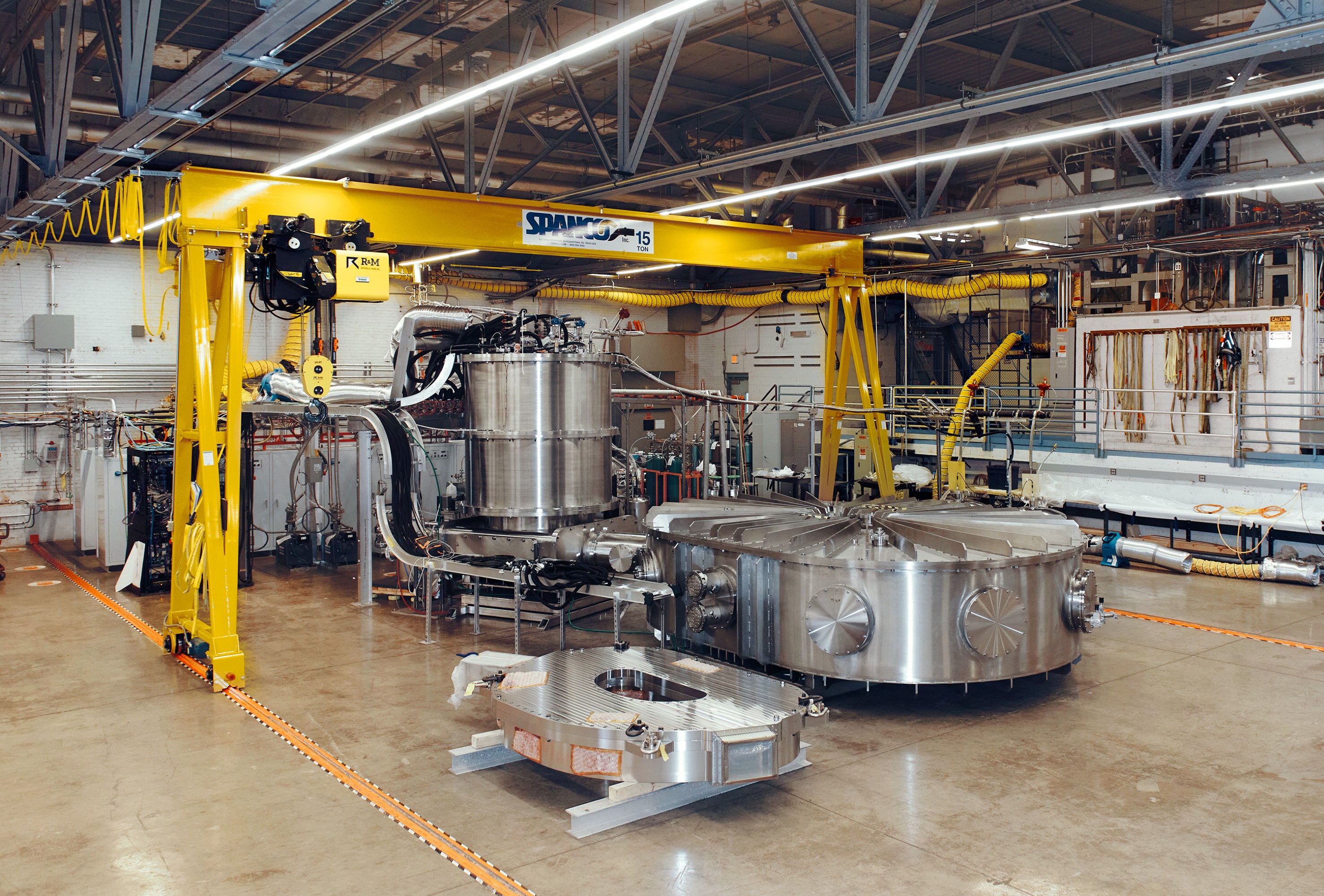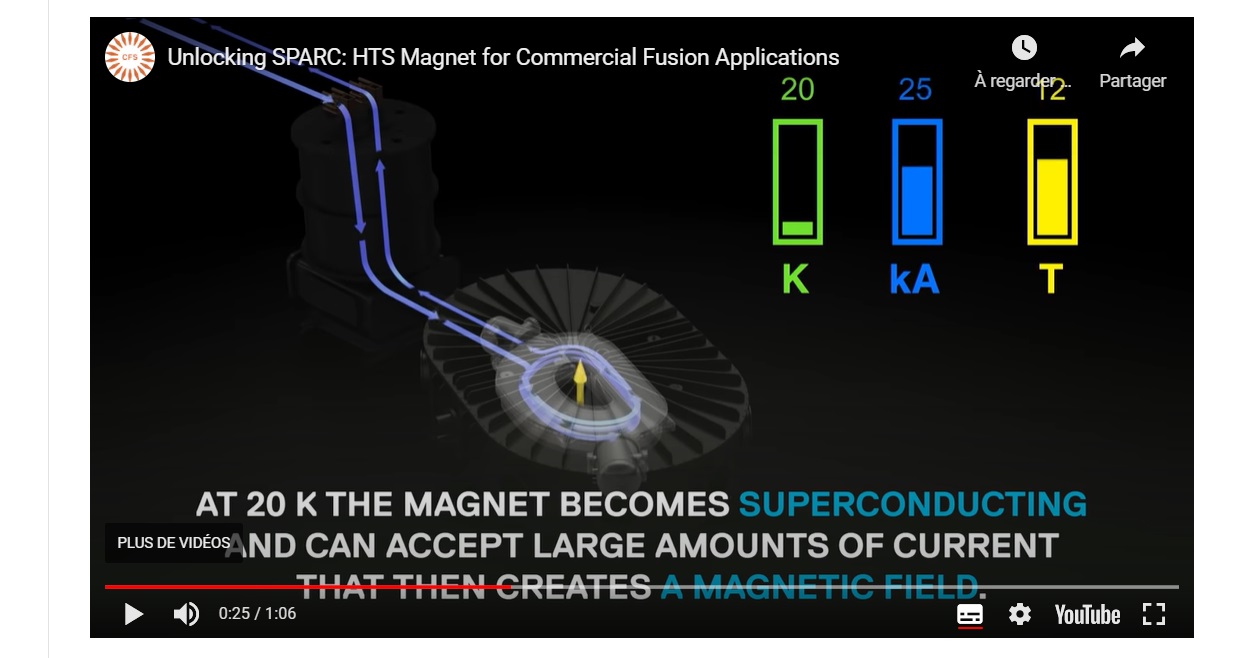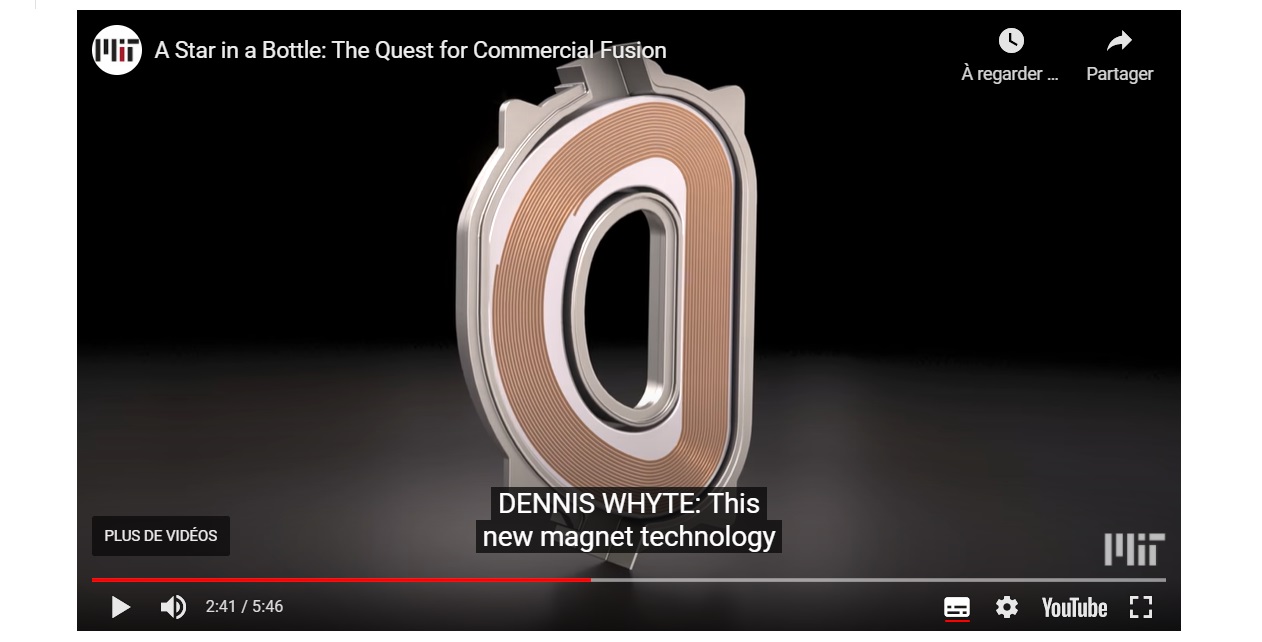par energy_isere » 25 févr. 2022, 09:14
Commonwealth Fusion lance le chantier de son réacteur SPARC dans le Massachusetts à 80 km de Boston.
Ils construisent une machine qui devrait étre préte en 2025.
Basé sur leur aimant à 20 Tesla, il y aura 18 de tels aimants à réaliser.
A hole in the ground could be the future of fusion power
MIT’s startup Commonwealth has a new powerful magnet that could finally make fusion power a reality.
By James Temple February 23, 2022 MIT Technology Review
On an overcast day in early December, a yellow earth mover scooped dirt from the edge of a deep pit in Devens, Massachusetts, on the site of an old Army base some 50 miles outside of Boston.
This is the future home of SPARC, a prototype fusion reactor that, if all goes as hoped, will achieve a goal that’s eluded physicists for nearly a century. It will produce more energy from fusing together atoms, the same phenomenon that powers the sun, than it takes to achieve and sustain those reactions.
By some point in 2025, the scientists at Commonwealth Fusion Systems expect, their machine will blow past that threshold, generating 10 times more energy than it consumes. That demonstration, they say, will enable the startup to develop full-size facilities capable of delivering as much electricity as a small coal plant by the early 2030s.
.....................
Commonwealth believes it can deliver a fusion machine that is the anti-ITER: small, fast to build, and far cheaper. The prototype should cost hundreds of millions of dollars, rather than tens of billions, and take years rather than decades to construct.
The key is a novel magnet the startup has developed. The field is watching the effort particularly closely because the team has already pulled off an indisputable scientific advance by using a new type of superconducting material to build the most powerful one of its kind. In a test last September, the magnet achieved a field strength of 20 tesla. It’s nearly twice as strong as ITER’s comparable magnet, which relies on earlier superconducting materials.
....................
 Commonwealth’s 20-tesla magnet and test stand, housed at MIT’s Plasma Science and Fusion Center.
Commonwealth’s 20-tesla magnet and test stand, housed at MIT’s Plasma Science and Fusion Center.
SPARC, the prototype reactor that Commonwealth is now building in Devens, will include 18 of those powerful magnets, surrounding the tokamak and generating the magnetic field that will tightly contain the plasma within. A paper coauthored by the Commonwealth team in September 2020 calculated that the prototype reactor could produce as much as 11 times more energy than it consumes.
Sorbom insists that the magnet test was the major engineering obstacle Commonwealth faced. Now, he says, it comes down to execution.
......................
https://www.technologyreview.com/2022/0 ... monwealth/
L'aimant 20 Tesla est refroidi à 20 Kelvin.

voir vidéo
https://news.mit.edu/2021/MIT-CFS-major ... nergy-0908

Commonwealth Fusion lance le chantier de son réacteur SPARC dans le Massachusetts à 80 km de Boston.
Ils construisent une machine qui devrait étre préte en 2025.
Basé sur leur aimant à 20 Tesla, il y aura 18 de tels aimants à réaliser.
[quote] [b]A hole in the ground could be the future of fusion power[/b]
MIT’s startup Commonwealth has a new powerful magnet that could finally make fusion power a reality.
By James Temple February 23, 2022 MIT Technology Review
On an overcast day in early December, a yellow earth mover scooped dirt from the edge of a deep pit in Devens, Massachusetts, on the site of an old Army base some 50 miles outside of Boston.
This is the future home of SPARC, a prototype fusion reactor that, if all goes as hoped, will achieve a goal that’s eluded physicists for nearly a century. It will produce more energy from fusing together atoms, the same phenomenon that powers the sun, than it takes to achieve and sustain those reactions.
By some point in 2025, the scientists at Commonwealth Fusion Systems expect, their machine will blow past that threshold, generating 10 times more energy than it consumes. That demonstration, they say, will enable the startup to develop full-size facilities capable of delivering as much electricity as a small coal plant by the early 2030s.
.....................
Commonwealth believes it can deliver a fusion machine that is the anti-ITER: small, fast to build, and far cheaper. The prototype should cost hundreds of millions of dollars, rather than tens of billions, and take years rather than decades to construct.
The key is a novel magnet the startup has developed. The field is watching the effort particularly closely because the team has already pulled off an indisputable scientific advance by using a new type of superconducting material to build the most powerful one of its kind. In a test last September, the magnet achieved a field strength of 20 tesla. It’s nearly twice as strong as ITER’s comparable magnet, which relies on earlier superconducting materials.
....................
[img]https://wp.technologyreview.com/wp-content/uploads/2022/02/20211129-wsj-cfs-0018-web-crop.jpg?w=2956[/img]
[i]Commonwealth’s 20-tesla magnet and test stand, housed at MIT’s Plasma Science and Fusion Center.[/i]
SPARC, the prototype reactor that Commonwealth is now building in Devens, will include 18 of those powerful magnets, surrounding the tokamak and generating the magnetic field that will tightly contain the plasma within. A paper coauthored by the Commonwealth team in September 2020 calculated that the prototype reactor could produce as much as 11 times more energy than it consumes.
Sorbom insists that the magnet test was the major engineering obstacle Commonwealth faced. Now, he says, it comes down to execution.
......................
[/quote]
https://www.technologyreview.com/2022/02/23/1045122/fusion-power-mit-startup-commonwealth/
L'aimant 20 Tesla est refroidi à 20 Kelvin.
[img]https://i.postimg.cc/Hkhhvd8v/Commonwealth-Fusion.jpg[/img]
voir vidéo https://news.mit.edu/2021/MIT-CFS-major-advance-toward-fusion-energy-0908
[img]https://i.postimg.cc/fRKjLNNW/Commonwealth-Fusion-aimant.jpg[/img]